Oracle's Modern Data Strategy
Considering enterprise data in terms of supply, demand, and transaction costs enables companies to craft more effective data strategies and increase return on data capital.
Learn how the unique capabilities of Oracle technology can put these ideas into action.
Shining A Light On The Hidden Data Economy
DATA IS CAPITAL
Data is a kind of capital. This isn't a metaphor like data is the new oil or data is the new gold. Data fulfills the literal, economic textbook definition of capital.
Capital is a produced good, not a natural resource. You have to invest to create it, not just dig it out of the ground. More importantly, capital is a necessary input into other goods and services. It's what economists call a factor of production. Without that factor, you can't make the product or deliver the service you have in mind.
For example, if you design a skyscraper but lack the financial capital to pay for its construction, you can't build it. Similarly, you can't deliver that service if you create a fraud detection algorithm but lack the data to feed it.
But, the way it creates value in your firm is through a data economy, hiding in plain sight inside your company.
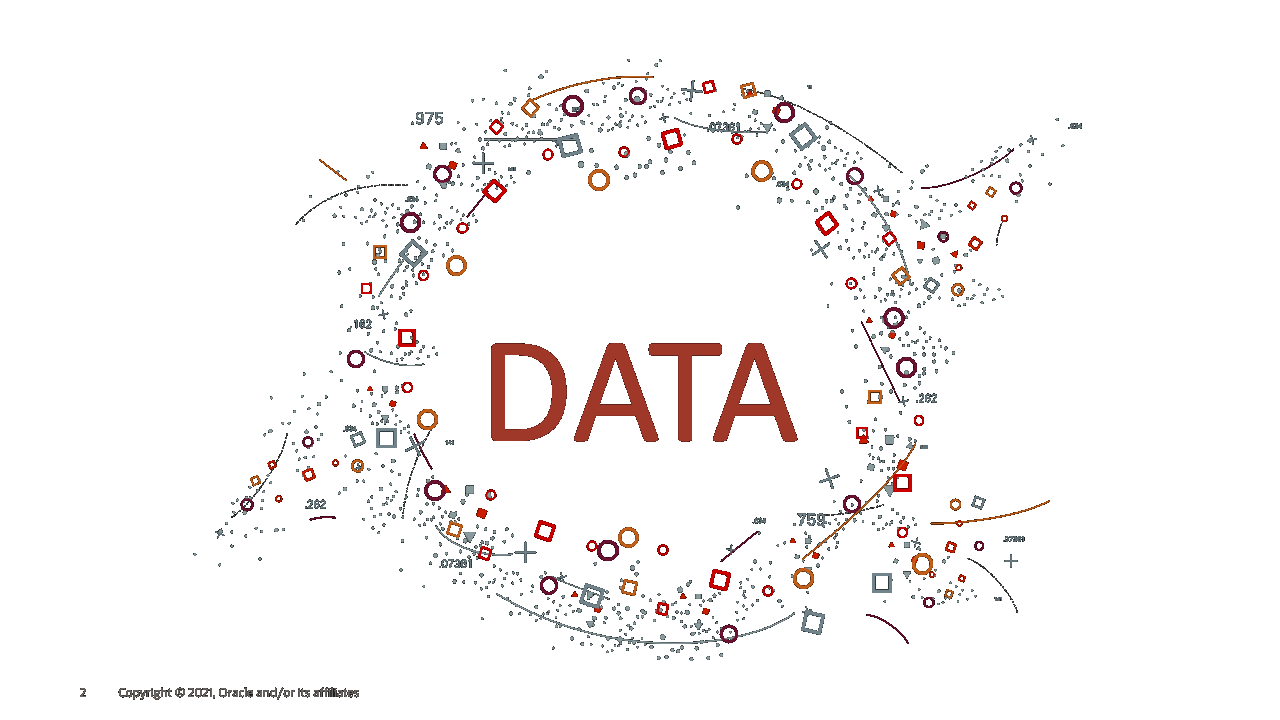
SEPARATE DATA ECONOMIES INSIDE YOUR ORGANIZATION
This hidden data economy has a supply-side where applications, sensors, and devices originate data in a wide variety of shapes and structures. And it has a demand-side where analytics and AI try to use that data in a wide variety of shapes and models.
Command Data Economy
The data economy in your organization most likely started as a supply-driven command data economy. The purpose of enterprise applications was to execute business processes. They created data as a side-effect. Some of that data would be packaged up for pre-determined questions in the form of reports and dashboards. This was the dominant internal data economy until the mid-2000s.

Informal Data Economy
But this left a lot of questions unanswered on the business side. This latent demand led to an informal data economy. Departmental IT staff created data stocks of their own, sometimes extracted from central systems. Departmental business analysts bought their own analytical tools to build new interactive dashboards and exploratory environments to satisfy the latent demand.
At the same time, new sources of supply emerged as company websites and mobile apps increased, providing the informal data economy with a diversified pool of data, enabling them to create new value outside the command data economy.
Through the 2010s, corporate IT attempted to respond by creating places to pool large amounts of diverse data and sanctioning a growing array of different analytical tools and frameworks to work on it. But this remained a largely informal data economy alongside the command economy.

Market Data Economy
Meanwhile, out on the Internet, something completely different happened. A market data economy arose. This market data economy was the polar opposite of the command economy in two critical ways. First, it completely decentralized both data supply and demand. The proliferation of websites, mobile apps, and internet services led to an explosion in available data, and APIs led to a chaotic blossoming of new uses of that data. Second, the market data economy blurred the distinction between supply and demand, between points of creation and points of use. Embedding analytics and AI into internet apps and services meant that using data created new data, driving a flywheel effect and, in some cases, a winner-take-all outcome.

Why does this matter?
Why does this matter to you? Because all three of these data economies are operating in your firm, usually separately.

DATA STRATEGY REINFORCES
COMPETITIVE STRATEGY
Let us take a big step back. The key is a data strategy that reinforces competitive strategy.
And to define strategy, we turn to Michael Porter, who is the godfather of competitive strategy. Porter described strategy as "creating unique value in a unique way."
It's not enough to create value your customer can only get from you. You have to deliver this value in a way your rivals cannot easily copy.
A firm's data strategy should reinforce its competitive strategy. Data strategy comes down to creating unique data assets and using them to enhance your firm's uniqueness. The way you use proprietary data assets should strengthen your differentiation, improve your cost position relative to rivals, or both.
But there is one more piece to a successful data strategy. It must also protect the observer, usually the company itself, and the observed, including customers, partners, and employees.
Because companies must balance data innovation with data compliance, any data strategy must consider the constraints of legislation, regulation, business ethics, and cultural norms when planning what data to capture and how to use it.
But how do you plan a data strategy that reinforces competitive strategy? The key is to examine the firm's activities.
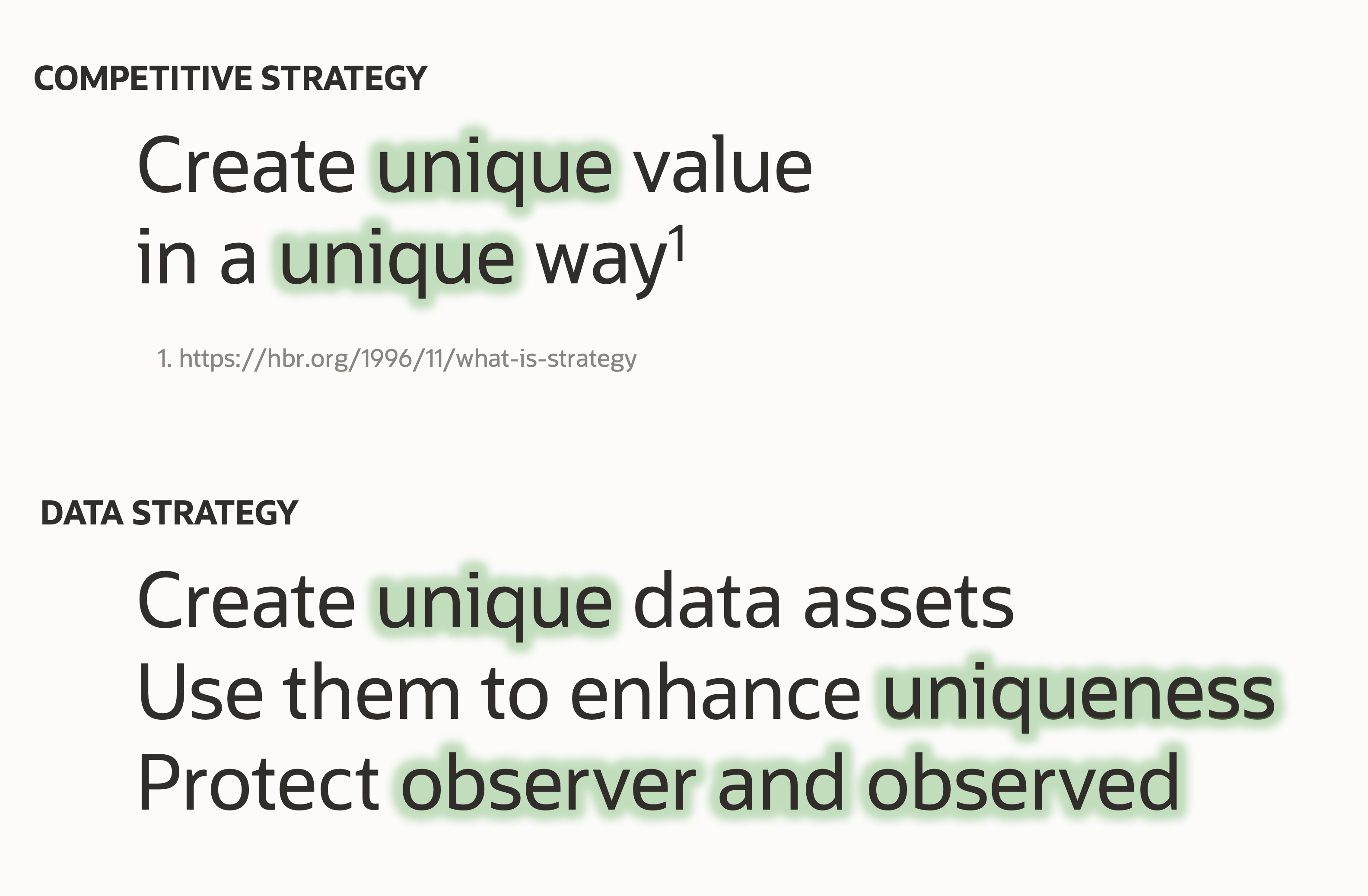
TYING EVERYTHING TOGETHER
Everything a firm does consists of activities. The firm's activities are an organization designs its products or services, the way it markets them, distributes them, and services them. Sustainable competitive strategy comes from creating a unique system of activities.
Use data to enhance uniqueness. Activities unique to you. Linkages among activities. Using data to make data
Create unique data assets. Activities special to you. Interactions with customers and partners where you're competing for data. Capturing more attributes, not just more instances
Protect observer and observed. Gather consent where necessary. Profile, aggregate, and anonymize. Control, track, and audit
So, how can a data strategy reinforce this competitive strategy?
BUILDING BLOCKS OF DATA STRATEGY
Domain ownership
Distributed ownership with teams close to the business domains responsible for creation or use
Variety of data product types
Passive-data that is something
Data Sets - data collections in different shapes/formats
Models - domain objects, data models, ML features
Libraries - inert algorithms, technical definitions of business semantics
Active-data that does something
Analytics - historical/real-time reports & dashboards
Algorithms - ML models, scoring, business rules
Data Services - docs, payloads, topics, authorization
Variety of implementations
Data products may be implemented using databases, lakes, and warehousesMultiple quality dimensions
Quality based on lineage
Quality relative to each job to be done
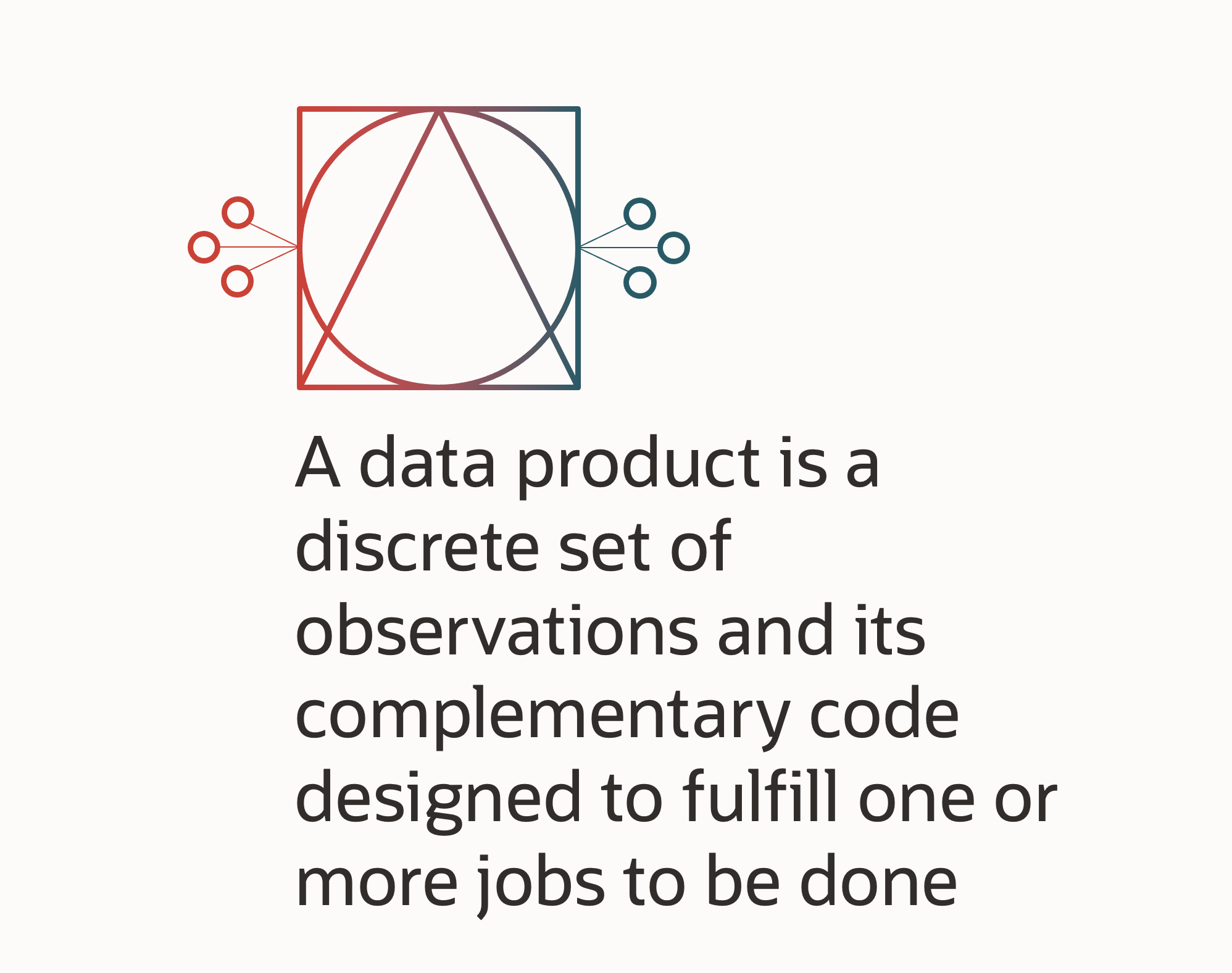
A TEXTBOOK EXAMPLE
Take Southwest Airlines in the late 1990s. Southwest was a low-cost, no-frills, short-haul carrier that shook up the airline industry. A unique set of interconnected activities allowed them to stake out a profitable position. Porter summarized the core activities in their system like this:
- - Limited passenger service
- - Short-haul, point-to-point routes between midsize cities and secondary airports
- - Very low ticket prices
- - High aircraft utilization
- - Lean, highly productive ground and gate crews
- - Frequent, reliable departures
Southwest Airlines used data to answer a tpyical business problem: Can we use predictive maintenance to get to 10-minute turnarounds?
- - Sensor data from engines, subsystems
- - Operational data - aircraft utilization, repair, maintenance, arrivals, and departures
- - Anonymize, mask employee (crew, engineers) records
- - Monitor model for performance as planes ages
These activities fit together in a unique system that made Southwest's tagline, "Southwest, the low-fare airline." not just a marketing slogan, but a defensible strategic position in a highly competitive industry.

A UNIFIED DATA ECONOMY REQUIRES A NEW DATA BACKBONE
To create a unified data economy, enterprises need a new data backbone. You need an enterprise architecture that helps you shift more activity into your market data economy, connect to critical back-office and financial data assets from your command data economy and bring the informal data economy into the fold.
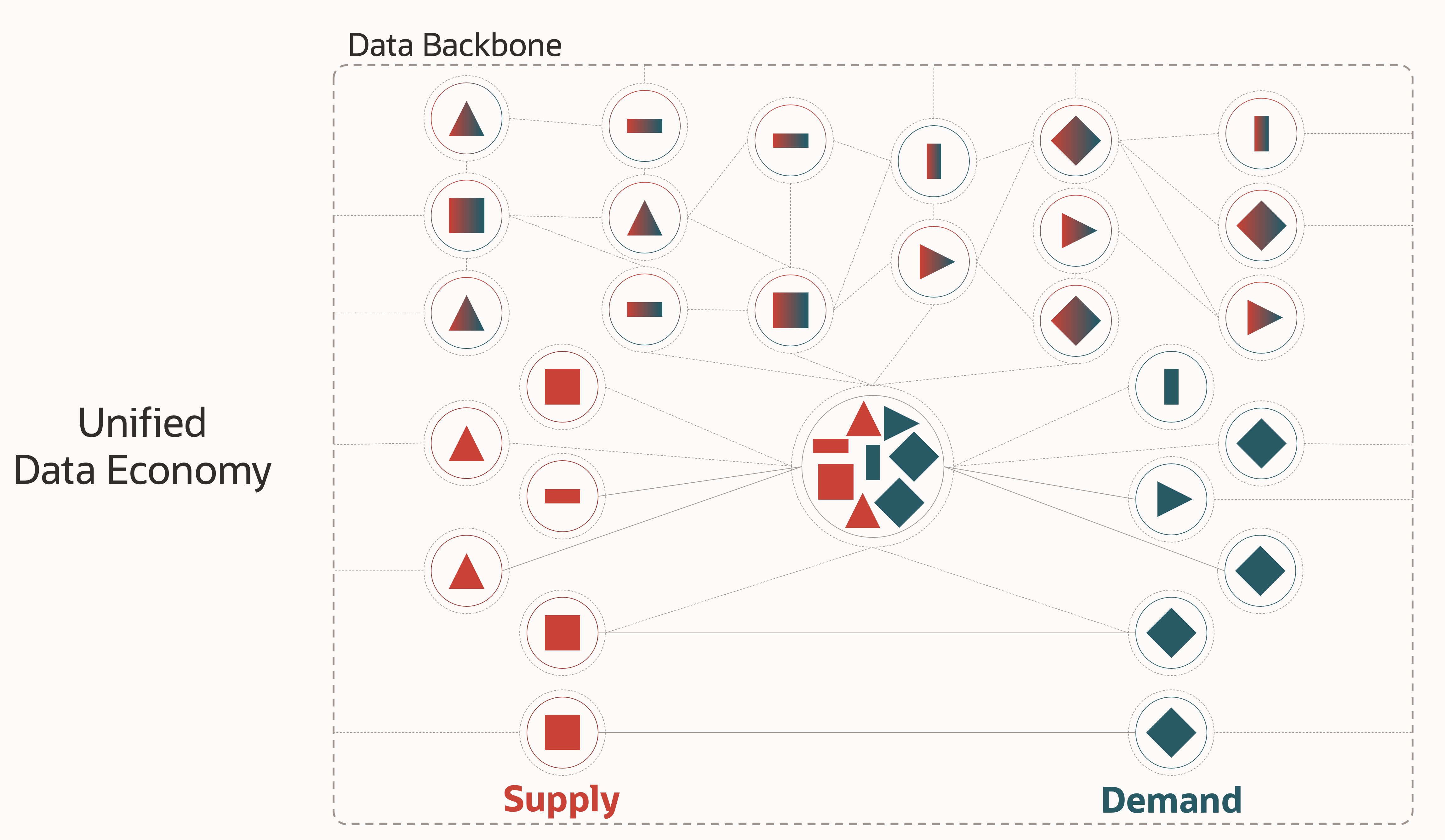
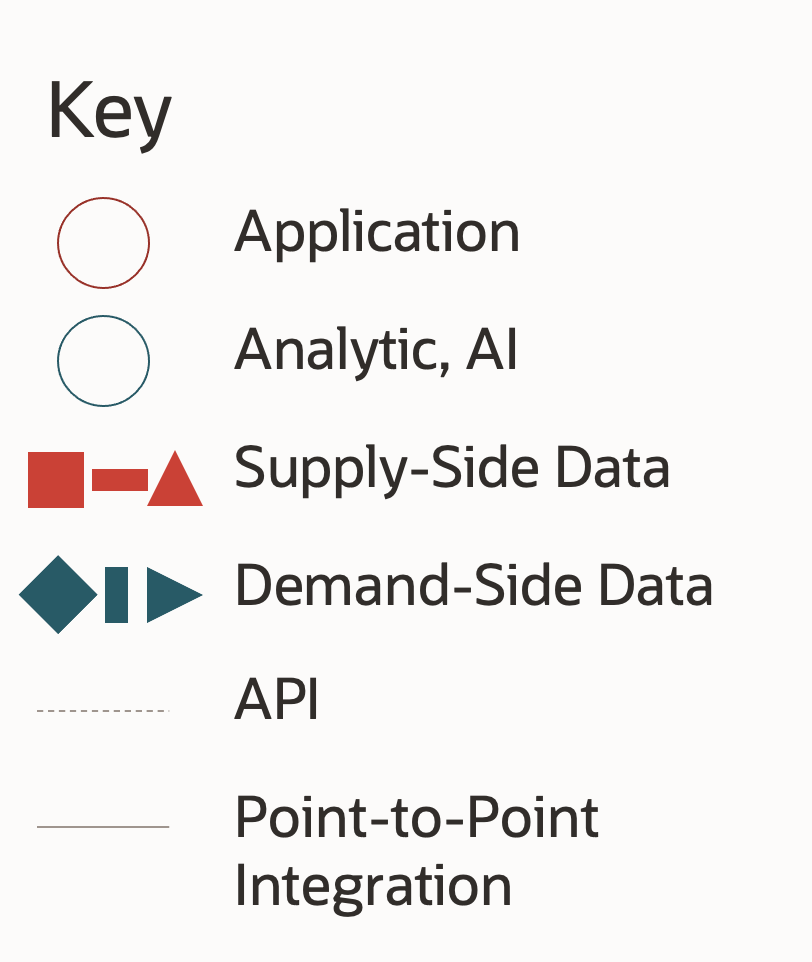
Four critical pillars for translating strategy into architecture
DATA LIQUIDITY
Ease of data reuse and recombination
(see note 1)
DATA PRODUCTIVITY
Value created as a result of data usage per unit of work, dollar invested or resource consumed
DATA SECURITY
Protections against external and internal threats
DATA GOVERNANCE
Assurances of data quality, compliance, ethics
Notes
1. https://cisr.mit.edu/publication/2021_0501_DataLiquidity_WixomPiccoli
Learn more about building a new data architecture in the cloud
Shining a Light on the Hidden Data Economy
Paul Sonderegger
Senior Data Strategist
Considering enterprise data regarding supply, demand, and transaction costs enable companies to craft more effective data strategies and increase return on data capital. Join us to learn how the unique capabilities of Oracle technology can put these ideas into action.
 Click to Watch |
 Run Workshop |

Automating Data Management for All
Andy Mendelsohn
Executive Vice President, Database Server Technologies
Oracle Autonomous Database has simplified the management of operational and analytical database workloads. This keynote discusses how the innovation continues to improve analyst, data scientist, and developer productivity.
 Click to Watch |
 Run Workshop |
| L | P |
| S | G |
Rethinking Database Architecture to Embrace Modern App Dev
Juan Loaiza
Executive Vice President
Mission Critical Database Technologies
What if you could develop modern, powerful, reliable apps using the latest development techniques without complicating your data architecture? This keynote introduces new Data Dev technologies that eliminate app complexity and accelerate development.
 Click to Watch |
 Run Workshop |
| P | S |
Oracle Database: What's New, What's Next
Jenny Tsai-Smith
Vice President, Product Management
Learn about recent Oracle Database news and developments and get a sneak peek of what's coming next from the Oracle Database development team.
 Click to Watch |
 Run Workshop |
| L | P |
Oracle Cloud Infrastructure GoldenGate: Elastic, Real-Time Data Integration Service
Denis Gray
Senior Director
Learn more about how this innovative, real-time data integration service can help with use cases such as ground-to-cloud replication, multi-region replication, and real-time data staging for data warehouses.
 Click to Watch |
 Run Workshop |
| L |
Oracle Autonomous Database: Simplify Your Database Management
Yasin Baskin
Director, Product Management
Learn more about how this innovative, real-time data integration service can help with use cases such as ground-to-cloud replication, multi-region replication, and real-time data staging for data warehouses.
 Click to Watch |
 Run Workshop |
| L |
All About Graphs in Oracle Database
Melliyal Annamalai
Distinguished Product Manager
Spatial and Graph
Graph is part of Oracle's converged database capabilities. Graph databases empower developers to build robust applications that uncover connections in data. Learn about these query and analytic capabilities and see how easy it is to get started with graphs using Graph Studio in Oracle Autonomous Database.
 Click to Watch |
 Run Workshop |
| P |
Oracle Autonomous Data Warehouse and the Data Lake
Marty Gubar
Director of Product Management
Big Data
Learn how to easily combine insights from your data lake and your data warehouse. Use Oracle Cloud Infrastructure Data Catalog to manage, search for, and understand all your data assets. Then, use Oracle Autonomous Database to analyze those assets at scale with no additional management.
 Click to Watch |
 Run Workshop |
| L | P |
| G |
Self-Service Data Warehousing
Patrick Wheeler
Vice President, Product Management
Oracle Autonomous Data Warehouse comes bundled with a powerful suite of data tools for business analysts and data scientists. Learn how you can manage and analyze your data - with no development or IT experience required.
 Click to Watch |
 Run Workshop |
| L | P |
Streamlining Security for Your Databases with Oracle Data Safe
Bettina Schaeumer
Senior Principal Product Manager, Database Security
Securing a database requires multiple technologies working together to reduce risk and improve compliance. Join us to learn how Oracle Data Safe combines the required capabilities into an easy-to-use cloud service that has you up and running in minutes.
 Click to Watch |
 Run Workshop |
| S | G |
In-Database Machine Learning: Automate, Scale, Deploy
Mark Hornick
Senior Director, Data Science / Machine Learning
Learn how Oracle Database and Oracle Autonomous Database deliver machine learning on database data using AutoML, scalable machine learning algorithms, and ease of deployment with SQL and REST interfaces, as well as open-source R and Python integration.
 Click to Watch |
 Run Workshop |
| L | P |
Superfast Event Stream Processing with a Converged Database
Tirthankar Lahiri
Senior Vice President
Data and In-Memory Technologies
Event streaming-in IoT and clickstream, for example-is a rapidly growing use case. This session introduces event stream workloads, provides requirements for event stream engines, and shares best practices for event stream processing using Oracle's converged database.
 Click to Watch |
| L |
Oracle Exadata: New Features and Functionality
|
Kothanda (Kodi) Umamageswaran Senior Vice President Exadata Development |
Subban Raghunathan Vice President |
Oracle Exadata Database Machine continues to pull away from the competition. Join Oracle product management experts for a discussion on the latest innovations and technologies used to make Oracle Exadata the world's fastest Oracle Database platform.
 Click to Watch |
| L |
Futuristic SQL: Making the impossible possible
Connor McDonald
Developer Advocate
Oracle Database
Many people learned SQL via the basics of SELECT-FROM-WHERE, and that is where their skillset has stayed. But Oracle's SQL reference is 1,500 pages alone! This session will show you modern SQL for better application development.
 Click to Watch |
| L |
Get into the Zone with Spatial in Oracle Autonomous Database
David Lapp
Product Manager
Oracle Spatial
The integration of maps and locations are expected in modern applications. How far is the nearest flood zone? Which assets are in a projected storm path? Learn how Spatial, a feature of Oracle Autonomous Database, answers location-based questions.
 Click to Watch |
 Run Workshop |
| P |
All about spatial in Oracle Database
David Lapp
Product Manager
Oracle Spatial
As part of Oracle's converged database, developers can use Oracle tools, APIs, and SQL to add maps and location analysis in any application. Learn about these industry-leading capabilities and see new, easy-to-use Spatial Studio in Oracle Database.
 Click to Watch |
 Run Workshop |
| P |
You Have a Machine Learning Model. Now What?
Marcos Arancibia
Senior Principal Product Manager,
Oracle Machine Learning
As part of Oracle's converged database, developers can use Oracle tools, APIs, and SQL to add maps and location analysis in any application. Learn about these industry-leading capabilities and see new, easy-to-use Spatial Studio in Oracle Database.
 Click to Watch |
| P |
Automating the Machine Learning Modeling Process
Mark Hornick
Senior Director,
Data Science / Machine Learning
Machine learning (ML) requires specific skills and a trial-and-error process. Learn about Oracle Machine Learning's no-code, AutoML for Python that help make ML more accessible and enhances data scientist productivity.
 Click to Watch |
| P |
Oracle Essbase Integration with Oracle Autonomous Data Warehouse
Ashish Jain
Senior Product Manager,
Essbase and Autonomous Database
The latest release of Oracle Essbase on the OCI Marketplace provides enhanced integration with Oracle Autonomous Data Warehouse. This new integration feature, available only to customers on OCI, is known as Federated Partitions in Essbase.
 Click to Watch |
| P |
Collect, Connect and Correct: Data Integration in Autonomous Database
|
Jayant Mahto Senior Principal Product Manager, Oracle Autonomous Database |
Bud Endress Senior Principal Product Manager, Oracle Autonomous Database |
Learn how Oracle Data Warehouse's Data Load and Transform tools make loading data from various apps, databases, and files a breeze. Quickly and easily profile, repair, and prepare your data for analysis and insights with these built-in tools.
 Click to Watch |
| L |
Introducing Oracle Data Integrator Web Edition
Jayant Mahto
Senior Principal Product Manager,
Oracle Autonomous Database
Oracle Data Integrator Web Edition combines the power and pedigree of an industry-leading tool with a simple-yet-powerful web interface. Join this session to explore the future of data integration and transformation in a self-service data warehouse.
 Click to Watch |
 Run Workshop |
| L |
Operational Data Lake for Capacity Planning and Analytics
Sriram Vrinda
Product Management
Observability and Management Group
Curate a data lake of telemetry from Oracle's Automatic Workload Repository (AWR), Enterprise Manager, Exadata, and more. Then, use OCI Operations Insights for long-term AWR and SQL performance analysis, capacity planning, and forecasting.
 Click to Watch |
| L | P |
Oracle Autonomous Database High Availability and Disaster Recovery
Nilay Panchal
Principal Product Manager
Oracle Autonomous Database
Peek under the hood at the highly available infrastructure that powers Oracle Autonomous Database while learning to shield your users from planned outages using Application Continuity, and unplanned, unpredictable outages with Autonomous Data Guard.
 Click to Watch |
| L |
Top Tips for Security and Networking in Oracle Autonomous Database
Can Tuzla
Principal Product Manager
Oracle Autonomous Database
Oracle Autonomous Database offers a complete, out-of-the-box security framework; however, did you know you can do more? Attend this session to learn everything you should know when it comes to network access and security in Autonomous Database.
 Click to Watch |
| S |
Database Activity Monitoring Made Simpler
Angeline Janet Dhanarani
Principal Product Manager
Oracle Database Security
Oracle Database provides the industry's most comprehensive auditing capability. Learn to create effective audit policies for monitoring database activity that are selective, targeted to your needs, and supportive of reliable threat detection.
 Click to Watch |
 Run Workshop |
| S |
Hands-on labs - explore the building blocks for a new data architecture
Important Tools for Everyone Using Oracle Autonomous Database Tools
Patrick Wheeler
Vice President, Product Management
Oracle Autonomous Database comes equipped with a powerful suite of tools that you'll get to use in this lab. First, provision a new Oracle Autonomous Data Warehouse and load data in just a few minutes. Next, profile, prepare, and transform that data-with insights, lineage, and impact analysis to follow.
 Run Workshop |
| L | P |
Boost Analytics Performance with Oracle Database In-Memory
Andy Rivenes
Senior Principal Product Manager
Witness the incredible performance boost Oracle Database In-Memory provides for analytic SQL. The lab explores what happens within the database to make this performance lift possible and explains why no application changes are required.
 Run Workshop |
| L |
Getting Started with Oracle Autonomous Database
Keith Laker
Senior Principal Product Manager
Nilay Panchal
Principal Product Manager
The labs in this workshop walk you through all the steps to get you started using Oracle Autonomous Database. You will provision a new Autonomous Database instance, load data, query your data, and create visualizations for data analysis. Autonomous Database makes it quick and easy for you to load and analyze your data.
 Run Workshop |
| L | P |
Oracle Cloud Data Lake House
Scott Wiesner
Senior Director, Data Management Business Development
Massimo Castelli
Senior Director, Product Strategy
A data lake house is not a single product; it is a solution that spans a large number of individual products and services. To highlight this solution, this session showcases the cohesive integration between the relational and data lake worlds, including the role played by the data catalog
 Run Workshop |
| L | P |
| S | G |
Get Started with Graph Analytics on Oracle Autonomous Database
Melliyal Annamalai
Distinguished Product Manager
Learn how Graph Studio makes it easy to explore relationships and discover connections in data to detect fraud or hidden dependencies. Get acquainted with its support for graph structures, comprehensive analytics, and intuitive
 Run Workshop |
| L | P |
Oracle Data Integrator - Basics Workshop
Jayant Mahto
Senior Principal Product Manager
This workshop will help you get started with Oracle Data Integrator (ODI). You will explore ODI using detailed examples to help you learn how to use Oracle Data Integrator to solve business problems.
 Run Workshop |
| L |
Database Security - Unified Auditing Workshop
Angeline Janet Dhanarani
Principal Product Manager
This workshop will help you Explore how to configure Oracle Unified Auditing to audit the database activity.
 Run Workshop |
| S |
Introduction to Oracle Spatial Workshop
David Lapp
Product Manager
This workshop will help you explore how to configure Oracle Unified Auditing to audit the database activity.
 Run Workshop |
| P |
Python Users: Build intelligent applications faster with Oracle Machine Learning Workshop
Mark Hornick Lapp
Senior Director, Data Science / Machine Learning
Explore how the Oracle Database natively supports Python through a series of real-world use cases, highlighting the broad set of algorithms and high-performance execution.
 Run Workshop |
| P |
Oracle Data Safe Fundamentals Workshop
Bettina Schaeumer
Senior Principal Product Manager
Explore Data Safe features - Activity Auditing, Data Discovery, Data Masking, User Assessment, and Security Assessment.
 Run Workshop |
| S | G |
Send Data from Oracle GoldenGate to OCI GoldenGate Workshop
Denis Gray
Senior Director
Learn to send data from your on-premises or Marketplace Oracle GoldenGate to Oracle Cloud Infrastructure GoldenGate.
 Run Workshop |
| L |